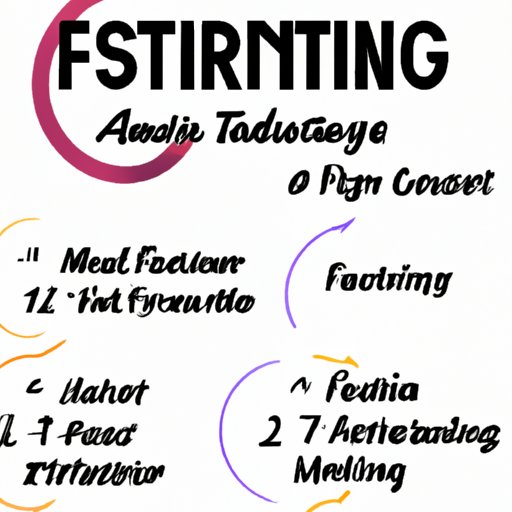
I. Introduction
Are you looking to improve your health and lose weight? Intermittent fasting may be the solution. With numerous benefits and long-term results, fasting has been gaining popularity in recent years. But how do you fast properly, while still maintaining your health and energy level? This comprehensive guide will provide you with all the tips and guidelines for a successful fasting experience.
II. Intermittent Fasting for Beginners: A Comprehensive Guide
If you’re new to fasting, it’s essential to understand what it is and how to do it effectively. Intermittent fasting involves restricting your calorie intake for a specific period, followed by a regular eating cycle. There are different types of fasting, including:
- 16/8 fasting: eat within an 8-hour window and fast for 16 hours
- 5:2 fasting: eat normally for 5 days and restrict calorie intake to 500-600 for 2 days
- 24-hour fasting: fasting for a full day, either once or twice a week
Intermittent fasting has multiple benefits, including improved insulin sensitivity, weight loss, and lower risk of chronic illnesses like diabetes and heart disease. To get started, choose a type of fasting that suits your lifestyle and stick to a regular routine.
III. The Do’s and Don’ts of Fasting: Tips for Making the Most of Your Fast
Before starting a fast, there are several things to consider. Ensure you’re in good health and not pregnant or breastfeeding. Don’t start a fast suddenly; instead, gradually reduce calorie intake over a few days. During fasting, it’s crucial to stay hydrated and drink plenty of water. Avoid consuming caffeine and alcohol, as they can disrupt your sleep cycle.
As tempting as it may be, don’t overeat during the eating cycle, as it can negate the benefits of fasting. Avoid sugary and processed food, and stick to nutrient-dense whole foods. Also, don’t use fasting as an excuse to indulge in unhealthy habits. Instead, focus on making sustainable lifestyle changes for long-term results.
IV. How to Stay Focused During a Fast: Strategies for Maintaining Productivity and Alertness
One of the most significant challenges during fasting is hunger pangs and lack of energy. To stay focused and alert, incorporate regular exercise into the fasting routine. Instead of high-intensity workouts, prioritize low-impact activities like yoga or walking. It’s also essential to stay hydrated and drink plenty of water, as dehydration can cause fatigue and headaches. You can also try incorporating mindfulness techniques like breathing exercises and meditation to enhance your fasting experience.
V. Breaking Your Fast: Navigating the Transition from Fasting to Feasting
Breaking your fast safely and effectively is crucial. Start with small, nutrient-dense meals, and avoid overeating. Opt for protein-rich foods like eggs, lean meat, and legumes. You can also include healthy fats like avocado and nuts. Avoid sugar and processed food, as they can cause a blood sugar spike and lead to overeating. Lastly, listen to your body and eat when you’re truly hungry, not just because it’s time to break the fast.

VI. Mindful Fasting: Using Meditation and Breathing Techniques to Enhance Your Fasting Experience
Combining mindfulness techniques like meditation and breathing exercises can enhance your fasting experience. Mindfulness can help reduce stress, improve focus, and increase self-awareness, all of which are crucial during fasting. Incorporate mindfulness into your fasting routine by setting aside a few minutes every morning for meditation or deep breathing exercises. This practice can also be beneficial during the eating cycle, helping to promote healthy eating habits.
VII. Combining Fasting with a Healthy Diet: Maximizing the Benefits of Your Fast
Combining fasting with a healthy diet can maximize the benefits of your fast. Opt for nutrient-dense whole foods like fruits, vegetables, lean protein, and healthy fats. Avoid processed food and sugar, as they can cause inflammation and lead to weight gain. Planning ahead and meal prepping can ensure you’re eating healthy during both the fasting and eating cycles.
VIII. Fasting and Exercise: How to Stay Active and Energized While Fasting
Exercising while fasting can provide numerous benefits, including increased fat burning and improved insulin sensitivity. Low-intensity workouts like walking, yoga, and Pilates can be beneficial, while high-intensity workouts may cause fatigue and disrupt the fasting state. It’s important to listen to your body and adjust your exercise routine to your fasting schedule. Also, remember to stay hydrated and drink plenty of water before, during, and after exercise.
IX. Conclusion
Fasting can provide numerous benefits for your health and overall wellbeing. However, it’s essential to fast correctly and safely to maintain your health and energy levels. By following the tips and guidelines provided in this comprehensive guide, you can ensure a successful fasting experience. Don’t forget to make sustainable lifestyle changes to maximize the long-term benefits of fasting and eating healthily.





